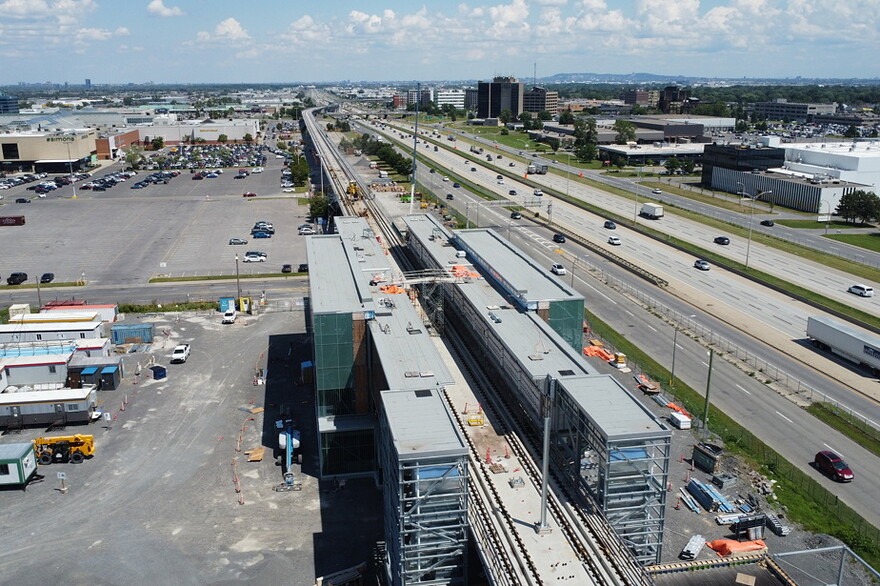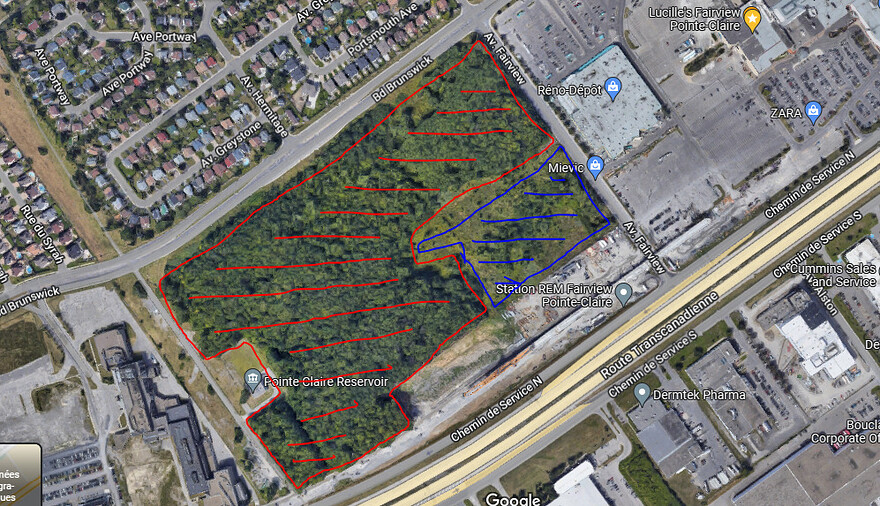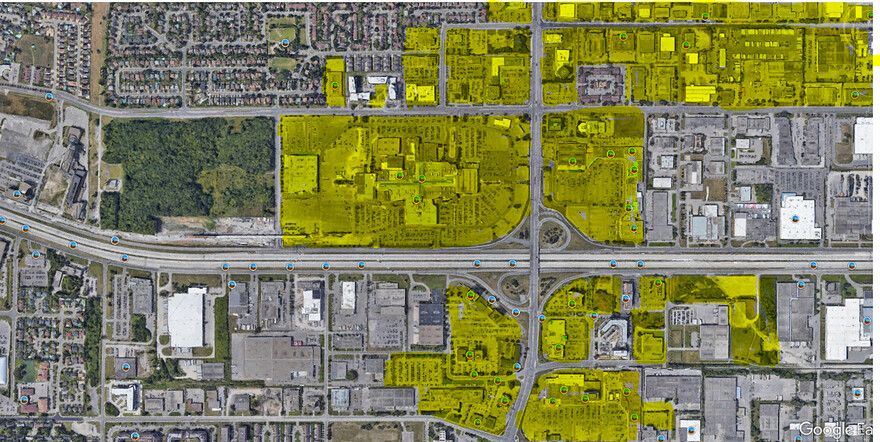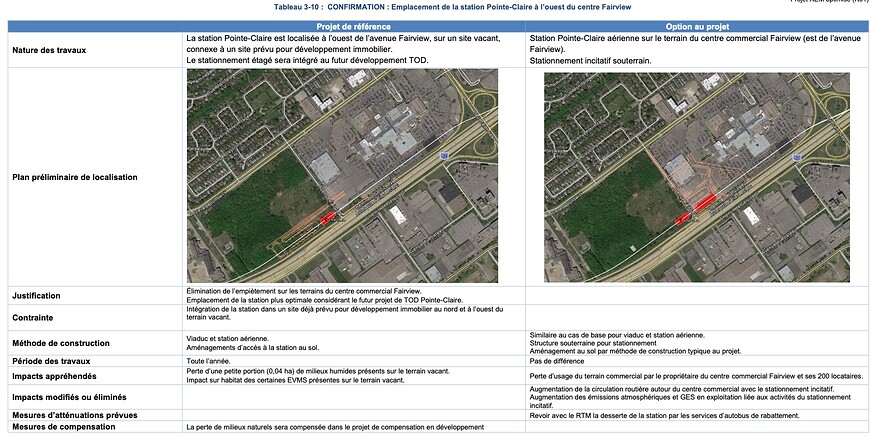La friche oui, mais une bonne partie du boisé n’a jamais été cultivée, seulement utilisée pour du bois de chauffage (probablement). Il y a sérieusement des parties qui méritent d’être conservées.
The only way to save this forest is to buy it from CF, it is after all private property. City evaluation has it at 35 million, when in reality its worth close to 80 million.
Il y aurait surement une façon de négocier avec CF pour permettre une densification plus importante du reste du site, surtout que le boisé est maintenant inclu dans le RCI, mais malheureusement je n’ai pas confiance en l’administration de la ville. Ça reste un dossier intéressant à suivre.
La mairie semble de mauvaise foi et instrumentalise le groupe; mais dans un article SFF disait ne pas être contre le développement aux abord de la station. S’ils en ont les moyens et ont réellement une position plus nuancée, ils devraient produire leur propre vision pour le boisé de (a) qu’est ce qui doit être conservé (b) qu’est ce qui doit être aménagé (c) et qu’est ce qui doit être développer.
Lettre d’opinion, rédigée par Jean-Marc Fournier, PDG de l’Institut de développement urbain du Québec, qui est parue aujourd’hui dans La Presse (plusieurs passages dans le texte sont liés au développement du secteur Fairview):
Environnement À Québec de nous rassembler
PHOTO MARTIN TREMBLAY, ARCHIVES LA PRESSE | Chantier du REM dans Pointe-Claire, dont la mairie veut « restreindre le nombre de résidants à proximité [de celui-ci] en contradiction avec les objectifs nationaux et régionaux », explique l’auteur.
À la suite des élections québécoises, tous les ordres de gouvernement auront des mandats valides jusqu’en 2025 et 2026. On peut espérer qu’ils sauront travailler ensemble sur des chantiers ayant des horizons qui dépassent le court terme. C’est certainement le cas pour la lutte contres les effets des changements climatiques
5 octobre 2022 | Publié à 10h00 | JEAN-MARC FOURNIER, PRÉSIDENT-DIRECTEUR GÉNÉRAL DE L’INSTITUT DE DÉVELOPPEMENT URBAIN DU QUÉBEC
Les élus de tous les niveaux ont établi des cibles de réduction de gaz à effet de serre (GES) au cours des dernières années. Dorénavant, il leur faudra adopter les moyens pour les atteindre. Pour l’Institut de développement urbain du Québec (IDU), il ne fait aucun doute que les différents gouvernements devront mettre au point une nouvelle approche de collaboration. Le défi ne pourra pas être relevé seulement par Ottawa, Québec ou Montréal. Les citoyens, à qui on demandera de changer leurs habitudes de vie, pourront certainement, à leur tour, exiger des décideurs qu’ils changent leur mode de gouvernance. Ils devront cesser de pelleter les responsabilités dans la cour des autres pour plutôt choisir de partager des tables communes afin de convenir d’actions concertées et suffisamment financées.
L’initiative de Québec
Le premier ministre du Québec est le premier qui peut envoyer ce signal de concertation intergouvernementale. Fort d’une nouvelle politique d’architecture et d’aménagement du territoire, il lui faudra bientôt nommer un nouveau conseil des ministres puis rédiger de nouvelles lettres-mandats et un discours inaugural. Il ne manquera pas d’occasions pour inviter tous les décideurs publics à une transformation de la gouvernance traditionnelle.
En reconnaissant l’importance de réduire les besoins en déplacements et d’accroître les capacités du transport durable, le premier ministre pourrait vouloir convenir d’une nouvelle relation avec les villes de manière à soutenir la reconfiguration urbaine. Chacun devra apporter sa contribution.
Déjà, on le répète depuis de nombreuses années, les villes n’ont pas les moyens financiers et fiscaux pour répondre aux défis auxquels font face leurs citoyens.
À cela s’ajoute maintenant le fardeau de transformer l’approche urbanistique de zonage exclusif soumis au « tout à l’auto » pour créer plutôt des quartiers de proximité reposant sur la mixité fonctionnelle et sociale.
Comme mesure structurante, l’IDU propose la création d’un ministère du Territoire – regroupant le ministère des Transports et celui des Affaires municipales et de l’Habitation –, ainsi que d’un Conseil du territoire – constitué d’experts indépendants – qui veilleront au respect des orientations gouvernementales. Ils devront, pour ce faire, accompagner les autorités municipales dans leurs efforts pour satisfaire aux nouvelles cibles en occupation du territoire, en kilomètres de desserte en transport durable et en logements à construire.
Mais les cibles ne règlent pas tout. Les villes auront besoin de soutien financier. Québec serait bien avisé d’interpeller Ottawa pour cofinancer un programme de transfert municipal avec des volets en habitation inclusive, en transport durable, en aménagement urbain et en requalification foncière.
En matière d’habitation, les capitales devraient s’entendre pour adopter des programmes complémentaires et arrimés. Le financement devra s’adapter aux diverses réalités foncières, être suffisant pour répondre aux cibles nationales et locales et être adéquat pour éviter les conséquences contre-productives des redevances. En matière de mobilité, Québec gagnerait à atteindre la parité dans les proportions de budgets des transports entre la voirie et le transport collectif d’ici 2025, ainsi qu’à cibler une proportion de 66 % en faveur du transport collectif d’ici 2027. Les budgets alloués à la requalification foncière devraient soutenir le redéveloppement en répondant notamment aux défis de la décontamination et de la protection du patrimoine. Enfin, le financement de l’aménagement urbain permettrait aux villes, entre autres, de planifier et réaliser les travaux d’infrastructures permettant de recevoir de nouveaux projets.
En contrepartie, Québec devrait insister pour que les décideurs locaux saisissent toutes les occasions de créer de nouveaux quartiers selon une densité adaptée aux différents milieux et suffisante pour justifier l’offre de services publics et privés de proximité. Ces quartiers devront également être planifiés pour offrir des emplois à leurs résidants à deux pas de chez soi. La décision de Pointe-Claire de restreindre le nombre de résidants à proximité du REM, en contradiction avec les objectifs nationaux et régionaux, illustre la nécessité de demander aux villes d’assumer leur rôle, elles aussi.
Le législateur québécois devrait modifier la fiscalité foncière pour favoriser la densification le long des parcours de transport collectif et, plus généralement, soutenir le multirésidentiel plutôt que d’encourager l’unifamilial.
Et il y a bien d’autres mesures à développer et à mettre sur pied…
Ensemble
Les gouvernements n’arriveront à rien s’ils se querellent les uns contre les autres ou s’ils renoncent à rassembler les citoyens en faveur d’une transition harmonieuse. À cet égard, l’annonce par le premier ministre de sa volonté de travailler avec les oppositions sur les enjeux environnementaux est de bon augure.
La transformation de nos vies respectives que commande l’urgence climatique doit se faire dans le respect des uns et des autres. Les réalités rurales sont différentes des réalités urbaines, il faut en convenir et s’adapter. La culture de l’automobile a, depuis des décennies, façonné nos habitats, nos habitudes commerciales et nos aspirations de voyages, pour ne nommer que quelques aspects. On ne peut pas raisonnablement tout bousculer. Entre le monde d’avant et le monde d’après, la transition appelle une main tendue entre gouvernements et entre citoyens, pas une dénonciation.
Pourquoi ne pas faire du prochain discours inaugural un appel à la coopération de tous les décideurs publics pour lancer un véritable mandat climat ?
Monsieur le Premier Ministre du Québec, la réponse vous appartient.
A wish for 2023: Can Fairview Forest remain a green oasis in suburbia?
John Meagher • Montreal Gazette
Last updated 2 days ago • 4 minute read
We talk to newsmakers from 2022 about their hopes for the new year. Today: the citizens behind the Fairview Forest grassroots movement.
The Fairview Forest exists as a green oasis in splendid isolation next to the cars and trucks that hurtle along Highway 40 in Montreal’s West Island. The densely wooded area is sandwiched between the CF Fairview shopping centre in Pointe-Claire and the old Merck Frosst site in Kirkland.
Until two years ago, no one made much of a fuss about preserving this mature forest, which has had several owners — local wildlife excluded — over the years. Cadillac Fairview acquired the land in 2013 from Smart Centres. At one time, John Abbott College had owned the property.A grassroots effort to preserve the forest began in earnest in late 2020 after developer Cadillac Fairview announced ambitious plans to redevelop the area west of the shopping centre into a “downtown” satellite city in the West Island.
A proposed project just west of Fairview Pointe-Claire shopping centre would transform 20 hectares of land into office space, a hotel and Main St.-style shops alongside rental apartments and condos. Cadillac Fairview
A group of citizens soon banded together to form the Save Fairview Forest (SFF) group with the aim of preserving the 43-acre site, including wetlands, in its entirety.
The SFF group started a petition and began holding a weekly protest walk around the forest perimeter. The group recently celebrated its 100th protest. More than 60 people showed up, including the Raging Grannies, a group of seniors who champion social causes in Montreal.
Geneviève Lussier, SFF’s spokesperson, says the weekly protests have served to boost public awareness about the environmental benefits of the forest. And the group will continue advocating tirelessly in 2023 — until they secure the land and trees for generations to come, she says.
“We are so blessed to have that forest there, still standing. To lose it would be an absolute travesty. I think people understand that. You cannot grow it back.
“If you tear down a mature forest, a large part of it being 100 years old, that’s unacceptable in this day and age. I think most people understand that the forest has value … especially next to a heat island (in the Fairview parking lot) and a highway.”
For the new year, she hopes their message will get through.
The opposing view? With the arrival of the light-rail REM expected in 2024 — the Fairview Pointe-Claire station is currently under construction near the southeast corner of the forest — the immediate area almost begs for some level of densification and a substantial residential offering.
Cadillac Fairview, whose attachment to the area dates back to 1965 when its namesake shopping centre was built, noted its mixed-use project would provide a “human-centric” community with residential and commercial offerings, all located within walking distance of a relocated STM bus terminal and the REM, which figures to whiz commuters downtown in under 30 minutes.
CF’s project was put on hold in 2022 after the City of Pointe-Claire imposed a temporary development freeze on the shopping mall/forest sector and other strategic parts of the city. The freeze remains in effect while Pointe-Claire overhauls its urban plan in the wake of rampant development in the city. CF subsequently launched a lawsuit against the city, arguing its project should be exempt from the freeze because it was too far along the planning process to be suddenly halted. The city has said otherwise.
The forest was also included in another development freeze by the Communauté métropolitaine de Montréal (CMM). The CMM adopted its Interim Control Bylaw (ICB) in April to protect natural environments and threatened species in the territory of Greater Montreal. It identified the forest territory, known as MU2 on the zoning map of Pointe-Claire, as being a “terrestrial and wetland environment of metropolitan interest.”
CF officials have noted from the outset that its mixed-use project would effectively deliver more residential housing, including a building dedicated to seniors, on what is now a 900-spot asphalt parking lot/heat island.
While critics might call that greenwashing, others say densification in close proximity to public transit hubs makes sense on many levels, not only to private developers like CF, but also to environmentalists hoping to slow the pace of urban sprawl.
A member of an environmental group that fought to preserve a forest in an off-island community told the Montreal Gazette in 2020 that forests and wildlife habitats in communities outside Montreal will face mounting pressure from private developers unless more densification and transit-oriented developments happen in major urban centres like Montreal.
Lussier understands that argument, but says urban forests like Fairview Forest are few and ecologically precious and must be preserved during a global climate crisis.
“As a group, we’ve never stated we’re anti-densification. Our main concern is the pressure it will cause unto the forest because it’s been so wild for so long.
“Densification does have an impact on green spaces,” she added. “It makes the case for the importance of the forest even (stronger) because … you have increased cars and increased heat, all things that can be mitigated by the forest.”
The forest contains old growth, groves of hemlock and beechnut, says Lussier, who can also rattle off the resident wildlife species. “There are foxes, a red-shouldered hawk that nests over the wetlands, a red-bellied snake, a salamander … ”
A brown snake at the Ecomuseum in Ste-Anne-de-
The forest is also home to the brown snake, a reptile exclusive to the Greater Montreal area. It was added to Quebec’s list of endangered species during the recent COP15 biodiversity conference in Montreal.
Lussier believes she is on the right side of a moral issue concerning the environmental impact trees have on the Earth’s climate.
“In 150 years from now, which is the age of some of those trees, we’re not going to be here. We cannot afford to lose it and we need to think about future generations with decisions we’re making today.”
I find it remarkable that none of these local journalists ever ask any members of the weekly protest walks what kind of SUVs they drive, or if they use public transit and bicycles to do their weekly shopping and other courses.
On top of that, are they questioning them on the effects of “If I don’t build here, I’m building somewhere else” problem? Housing not built here is built on farmland or forest off-island with an even bigger climate impact.
To be clear, I’m not in favour of razing the forest, but I think allowing some development immediately around the station in the forest is warranted as well as properly turning the park into a more useable and accessible space with proper pathways and the like, especially when the Merck project is complete. Kinda like below, where the red is off-limits and to be turned into a formal, usable nature park and the rest is left for 15 stories plus ground level services such as daycares, groceries that might be useful to commuters.
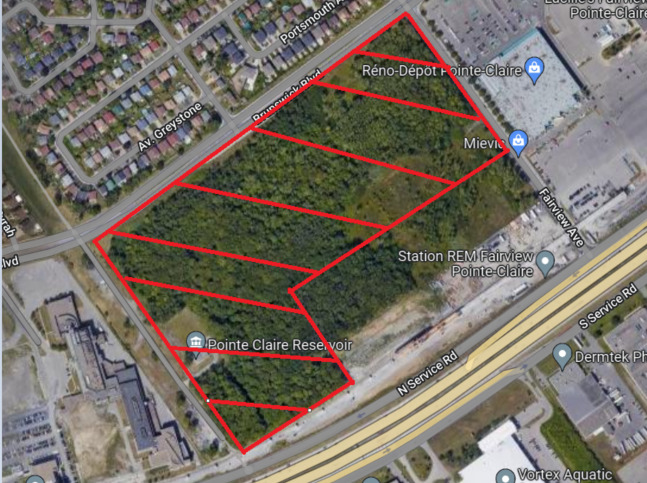
Their opposition to the parking lot development because “its a first step in a slippery slope” is ludicrous. There will be a protracted legal battle which will serve absolutely no one but the lawyers so I hope that this can be resolved.
Same, 100%. I don’t expect the plan was to make it concrete from corner to corner, but Tim Thomas and his cronies, with the backing of a very vocal suburban NIMBY community, have put the kibosh on all development, including over the asphalt parking lot that is normally used to pile snow and trash from all around the dozens of hectares of Fairview parking lot. I’m almost 100% certain that CF proposed a rather exuberant original plan for the site with the intention of coming to some sort of compromise. I do not think Salpeter et al expected a door slammed in their faces.
If it was really about the small wooden lot (not a forest), we’d be seeing construction over the parking lots and car dealerships around exo1 and line A.
At the end of the “pubic consultations” like or not the city will have to have some development on this land. They can protest all they want, eventually it will happen.
Je n’y crois pas honnêtement. Qu’on y construise ou pas des logements ne changera rien aux milieux naturels et agricoles menacés en périphérie de la région urbanisée. C’est là bas qu’il faut agir pour la protection et la conservation des milieux naturels. Je ne pense vraiment pas qu’on verrait une corrélation entre la construction de logements ici et la diminution de la pression immobilière en couronne. Au mieux, ça retarde un peu un projet quelque part en banlieue hors-ile, mais ce serait vraiment surprenant.
Je partage quand même pas mal le reste de ton commentaire, à l’exception de l’image, puisqu’on viendrait amputer dans la partie la plus intéressante du boisé. La seule partie du boisé que j’accepterais qu’on développe est celle en bleue, tandis que toute la partie en rouge devrait être conservée, à mon avis. Il s’agit dans ce cas plutôt d’une friche qui a déjà été maganée par le passé, mais même là, à voir la quantité d’espaces développables tout juste à proximité, je ne comprends vraiment pas pourquoi on chercherait à développer le boisé, puisque ce n’est pas de l’espace qu’il nous manque.
À noter que j’ai mis en jaune des superficies industrielles / commerciales qui ont leur place dans un contexte urbain, mais je suis convaincu qu’il y est possible de revitaliser ces terrains
En effet, je ne dirais pas non plus qu’il s’agit d’une forêt, mais le terme « petit lot boisé » me semble également inapproprié, visant à réduire son importance. Il s’agit d’un boisé (qui est pas mal intéressant d’un point de vue écologique d’ailleurs) en contexte urbain, donc enclavé, isolé, perturbé et de plus petite taille. Cependant, ça ne diminue pas son rôle et sa valeur écologique. Justement, la faible superficie du boisé nécessite qu’on y touche pas davantage, y compris dans son secteur en friche, afin de préserver son intégrité écologique restante. Pour un boisé urbain, il est pas mal plus intéressant que la moyenne.
Je suis quand même un peu étonné de voir qu’autant de membres ici soient aussi peu favorables à la cause avancée par le groupe. Je pense que c’est par opposition au nimbysme - ce qui est parfaitement valable - or, je crois aussi qu’il est possible d’avoir la même opinion qu’eux sur la protection du boisé, tout en rejetant l’argumentaire anti-développement. Il faut protéger le boisé et il faut développer tous les sites à proximité.
Est-ce qu’on a une idée des scénarios et timelines de dénouements possibles pour voir comment ça s’alignerait avec la mise-en-service de la station?
Mais… mais… mais la station est dans le boisé fricheux, et non là où elle aurait dû être, au coeur du secteur à l’angle de St-Jean et de la 40, il est donc logique de proposer un plan d’aménagement des terrains inutilisés autour de la future station. Nous ne saurons probablement jamais la vraie raison pour laquelle CDPQinfra a choisi cet emplacement plutôt qu’à l’extrémité est de la propriété CF Fairview. C’est d’autant plus bizarre que, jusqu’à il y a deux ans, la Caisse était propriétaire à 50 % du terrain de CF Fairview.
ie, CF owns the woods, they don’t own any of the properties in yellow other than CF Fairview; why would they propose to build on land they do not own. Yes, I believe the entire CF Fairview mall should be razed and redeveloped instead of building out the greenfield next door, but it’s understandable that a land owner would logically choose the simpler, cheaper route of building on greenfield instead of demolition and redevelopment, which we know is multiples more expensive and complicated.
En effet, CF ne possède pas tous les lots en jaune, je suggérais plutôt que la ville devrait pousser le développement de ce côté là afin de préserver le boisé (chose qui n’arrivera jamais sous l’administration actuelle).
De toute façon, le boisé ayant été inclus dans le RCI-96 de la CMM, il est présentement protégé. Ça reste beaucoup plus facile pour CF de développer le centre commercial, que de s’attaquer à un site si politisé. CF est en bonne partie responsable du RCI de Pointe-Claire sur toute nouvelle construction. Le promoteur aurait du prévoir qu’il allait y avoir du nimbysme pour n’importe quel projet, mais qu’en passant sur le boisé, il donnait des armes aux opposants du projet. De plus, dans les premiers stades de propositions, l’opposition n’était pas encore particulièrement forte et une écoute de la part du promoteur pour proposer un projet respectant le boisé aurait certainement apaisé la mobilisation afin qu’elle ne mène pas à la situation d’aujourd’hui.
I really like how First Capital went about it in Cote-des-Neiges. Sure, CF site is 15 times bigger, but they also benefit from being removed from the rest of the neighborhood and not building in a dense and lively area.
With the Merck campus redevelopment, the Jacques Bizard boulevard extension project, I feel a large urban park with what’s left is the most sensible scenario.
They actually gave the option of having the entire bus terminal over the property (with just the station above the green area) instead of cutting into the wooded land:
Yup. Money talks, and bullshit walks.
Everyday Pointe-Claire citizens who support the city councilors cant even attend council meetings as the Mayor and he usual entourage of complainers drown out any supporters of the city councilors , its an embarrassment to the taxpayers of the city
Pointe-Claire council approves private talks with Cadillac Fairview
Geneviève Lussier of Save Fairview Forest group said there are many “red flags” with council’s resolution to open private talks with CF.
(2023-01-30 Assemblée Extraordinaire de la Ville de Pointe-Claire - Pointe-Claire - Chaînes - WEBTV.COOP) to forge ahead with discussions between the city and developer Cadillac Fairview regarding its development plans for the Fairview shopping centre parking lot and Fairview Forest.
The resolution, as put forth by council, is “for the purpose of ensuring public participation in determining the future of zones MU1 and MU2.”
The six members who voted in favour of “kick-starting” talks with Cadillac Fairview were Brent Cowan, Eric Stork, Tara Stainforth, Cynthia Homan, Kelly Thorstad-Cullen and Paul Bissonnette.
Bruno Tremblay, whose district includes , was the lone dissenting councillor. Mayor Tim Thomas also voted against the resolution, which had been put forth at another special meeting on Jan. 19. The resolution was then passed, but Thomas used his mayor’s veto to defer the matter until the next regular council meeting in February. But council convened Monday’s meeting to reintroduce the resolution, arguing the mayor’s action did not meet the criteria for using a veto. As the Montreal Gazette reported Sunday, however, [Quebec law doesn’t stipulate criteria] for a mayor’s use of a veto.
“What is disturbing about the resolution tonight is that it allows the public participation process to be controlled by the city in conjunction with the developer, as opposed to vice versa,” Thomas said at the meeting. “I would prefer to have public consultation first.”
During public question period, resident Mark Abley said the resolution directs city manager Karina Verdon to negotiate in private with Cadillac Fairview on the “basis of a mandate letter no members of the public have been allowed to see.”
“The public had no way of knowing if the mandate letter was truly in their interest. Surely it would be both weird and wrong if members of Parliament or … the National Assembly voted on a law before any member of the public had a chance to know what the law contained.”
Abley, a former Montreal Gazette columnist, said the resolution suits the “corporate agenda, but I don’t believe it suits the public agenda.”
About a year ago, Pointe-Claire council voted to put a [temporary development freeze] on several key areas in the city, including MU1 and MU2, while it overhauls its urban planning program. Cadillac Fairview subsequently took [legal action] against the city.
This new resolution mandates the Pointe-Claire city manager to “meet forthwith with representatives of Cadillac Fairview in-camera (to) work out with them a mutually agreeable path forward” on future site planning.
“Letting a private corporation with a vested financial interest have a say — and excluding the public — in what type of public participation will take place is concerning,” she said in a statement.
“The goal of this process is to remove both MU1 and MU2 prematurely from the freeze. The resolution uses the term ‘mutually agreeable path forward,’ implying a consultation process that is mutually agreeable to both CF and the city, not necessarily one that will ensure the greatest amount of public participation,” Lussier added.
But Cowan said the resolution’s purpose “is only to get Cadillac Fairview to agree to get to the table with citizens. And if that mutually agreeable accord can’t happen, well, then Cadillac Fairview will just have to sit and watch from the sidelines.”
The resolution is “non-binding,” Stork said. “If we don’t agree with it, we tell them to go home. It’s just a start to a discussion, plain and simple.”
In April 2022, Pointe-Claire council [voted to exclude the massive Cadillac Fairview] parking lot project from its new Interim Control draft bylaw, or development freeze. But council [later reversed]that decision and put Cadillac Fairview back in the freeze.
The ICB freeze is “a temporary measure,” Cowan said. “You can’t keep dragging your heels on it. It’s been a year; this process has taken too long.”
Thomas said the city already had a timeline in place to begin public participation in revising the town’s urban plan. “There has been no delay, in my mind, whatsoever.”
